climate control FORD E SERIES 2013 4.G Owners Manual
[x] Cancel search | Manufacturer: FORD, Model Year: 2013, Model line: E SERIES, Model: FORD E SERIES 2013 4.GPages: 416, PDF Size: 4.29 MB
Page 2 of 416
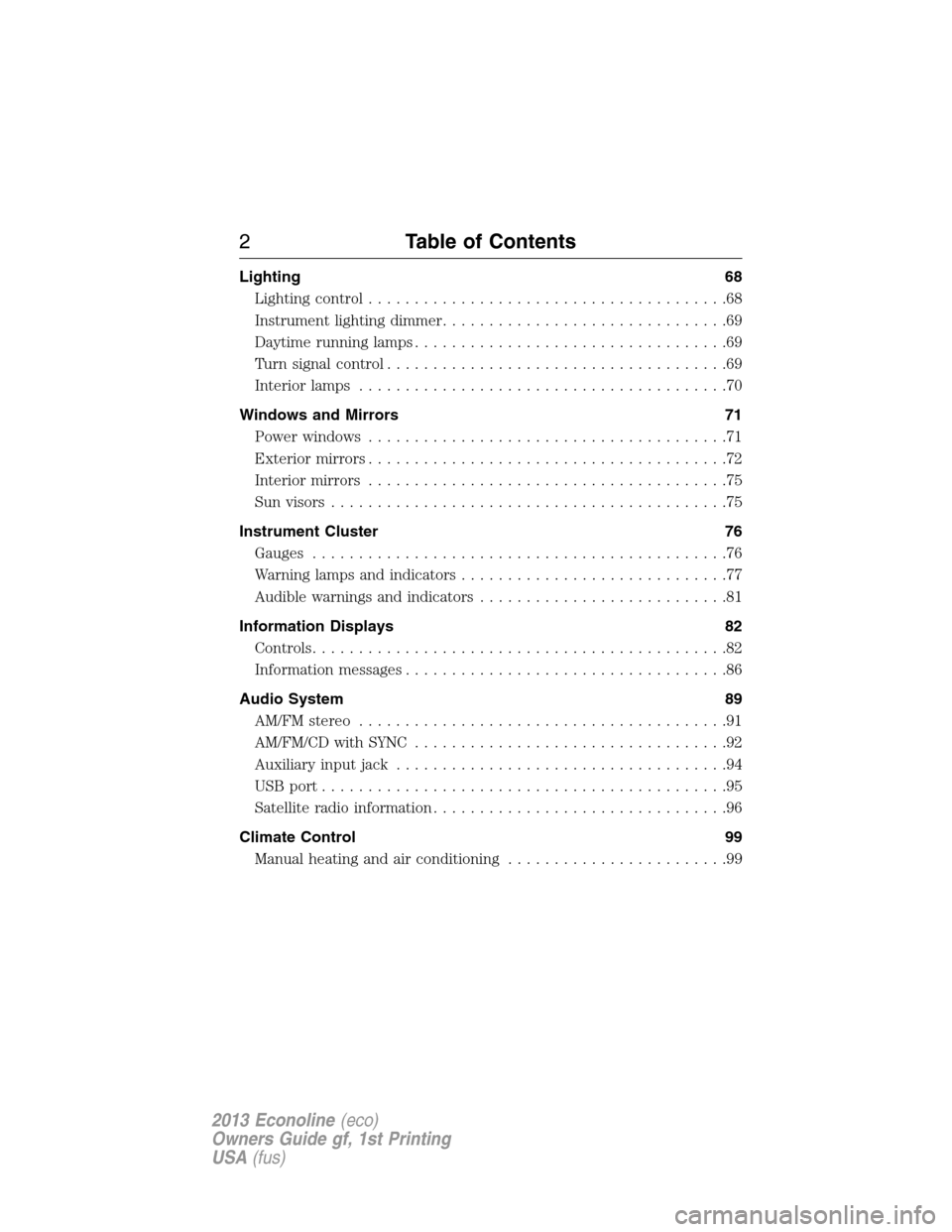
Lighting 68
Lighting control.......................................68
Instrument lighting dimmer...............................69
Daytime running lamps..................................69
Turn signal control.....................................69
Interior lamps........................................70
Windows and Mirrors 71
Power windows.......................................71
Exteriormirrors.......................................72
Interiormirrors .......................................75
Sunvisors ...........................................75
Instrument Cluster 76
Gauges.............................................76
Warning lamps and indicators.............................77
Audible warnings and indicators...........................81
Information Displays 82
Controls.............................................82
Information messages...................................86
Audio System 89
AM/FMstereo ........................................91
AM/FM/CD with SYNC..................................92
Auxiliary input jack....................................94
USB port............................................95
Satellite radio information................................96
Climate Control 99
Manual heating and air conditioning........................99
2Table of Contents
2013 Econoline(eco)
Owners Guide gf, 1st Printing
USA(fus)
Page 99 of 416
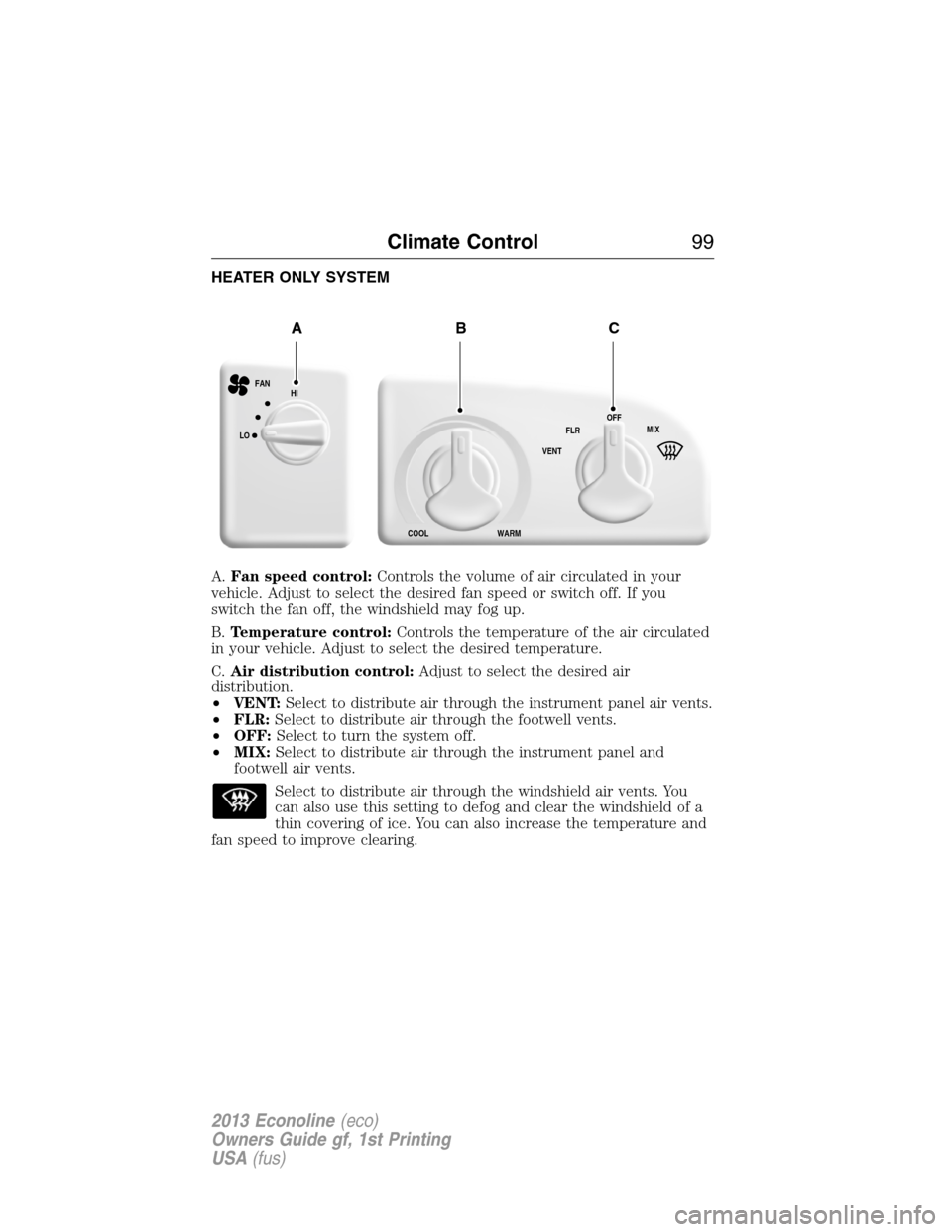
HEATER ONLY SYSTEM
A.Fan speed control:Controls the volume of air circulated in your
vehicle. Adjust to select the desired fan speed or switch off. If you
switch the fan off, the windshield may fog up.
B.Temperature control:Controls the temperature of the air circulated
in your vehicle. Adjust to select the desired temperature.
C.Air distribution control:Adjust to select the desired air
distribution.
•VENT:Select to distribute air through the instrument panel air vents.
•FLR:Select to distribute air through the footwell vents.
•OFF:Select to turn the system off.
•MIX:Select to distribute air through the instrument panel and
footwell air vents.
Select to distribute air through the windshield air vents. You
can also use this setting to defog and clear the windshield of a
thin covering of ice. You can also increase the temperature and
fan speed to improve clearing.
HI
LO
COOL WARMVENTFLROFF
MIX FAN
ABC
Climate Control99
2013 Econoline(eco)
Owners Guide gf, 1st Printing
USA(fus)
Page 100 of 416

MANUAL CLIMATE CONTROL
A.Fan speed control:Controls the volume of air circulated in your
vehicle. Adjust to select the desired fan speed or switch off. If you
switch the fan off, the windshield may fog up.
B.Temperature control:Controls the temperature of the air circulated
in your vehicle. Adjust to select the desired temperature.
C.Air distribution control:Adjust to select the desired air distribution.
•MAX A/C:Select to distribute maximum air conditioning through the
instrument panel air vents. This mode is more economical and efficient
than normal air conditioning.
•NORM A/C:Select to switch the air conditioning on or off. Air
conditioning cools your vehicle using outside air. To improve air
conditioning when starting your vehicle, drive with the windows slightly
open for two to three minutes.
•VENT:Select to distribute air through the instrument panel air vents.
•OFF:Select to turn the system off.
•FLR:Select to distribute air through the footwell vents.
•MIX:Select to distribute air through the instrument panel and footwell
air vents.
Select to distribute air through the windshield air vents. You
can also use this setting to defog and clear the windshield of a
thin covering of ice. You can also increase the temperature and
fan speed to improve clearing.
HI
LO
COOL WARMVENT
NORM
A/C
MAX
A/COFF
MIX FLR FAN
ABC
100Climate Control
2013 Econoline(eco)
Owners Guide gf, 1st Printing
USA(fus)
Page 101 of 416
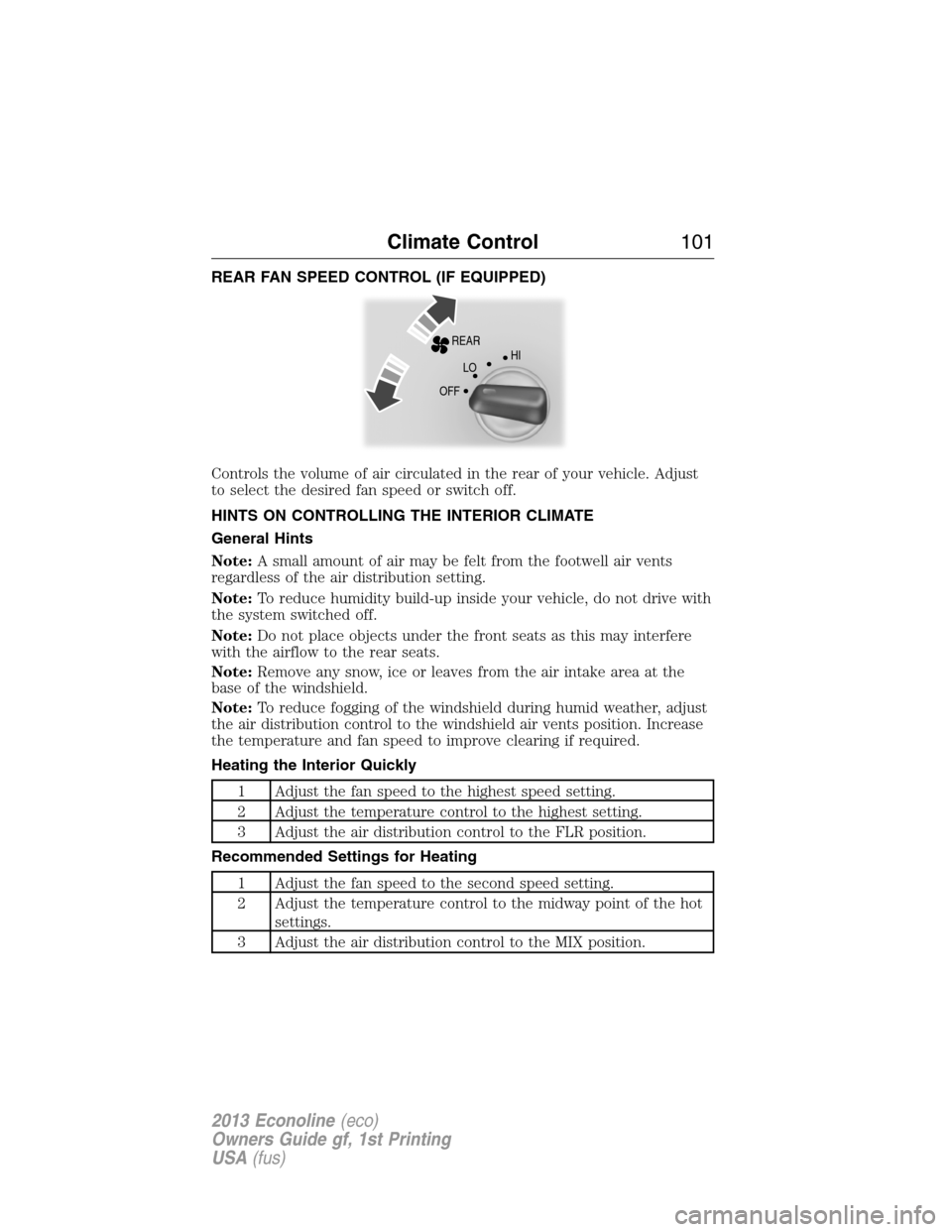
REAR FAN SPEED CONTROL (IF EQUIPPED)
Controls the volume of air circulated in the rear of your vehicle. Adjust
to select the desired fan speed or switch off.
HINTS ON CONTROLLING THE INTERIOR CLIMATE
General Hints
Note:A small amount of air may be felt from the footwell air vents
regardless of the air distribution setting.
Note:To reduce humidity build-up inside your vehicle, do not drive with
the system switched off.
Note:Do not place objects under the front seats as this may interfere
with the airflow to the rear seats.
Note:Remove any snow, ice or leaves from the air intake area at the
base of the windshield.
Note:To reduce fogging of the windshield during humid weather, adjust
the air distribution control to the windshield air vents position. Increase
the temperature and fan speed to improve clearing if required.
Heating the Interior Quickly
1 Adjust the fan speed to the highest speed setting.
2 Adjust the temperature control to the highest setting.
3 Adjust the air distribution control to the FLR position.
Recommended Settings for Heating
1 Adjust the fan speed to the second speed setting.
2 Adjust the temperature control to the midway point of the hot
settings.
3 Adjust the air distribution control to the MIX position.
REAR
HI
LO
OFF
Climate Control101
2013 Econoline(eco)
Owners Guide gf, 1st Printing
USA(fus)
Page 102 of 416
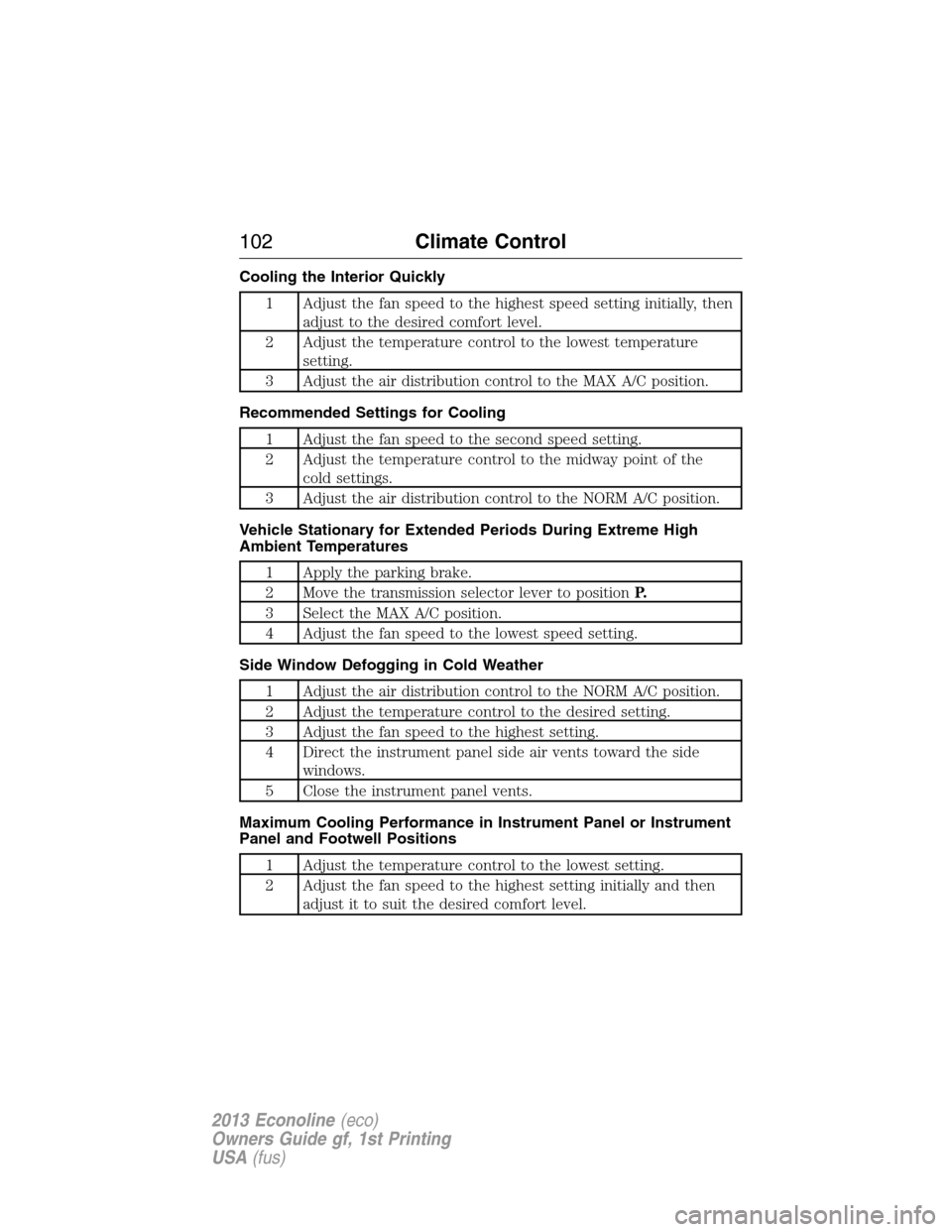
Cooling the Interior Quickly
1 Adjust the fan speed to the highest speed setting initially, then
adjust to the desired comfort level.
2 Adjust the temperature control to the lowest temperature
setting.
3 Adjust the air distribution control to the MAX A/C position.
Recommended Settings for Cooling
1 Adjust the fan speed to the second speed setting.
2 Adjust the temperature control to the midway point of the
cold settings.
3 Adjust the air distribution control to the NORM A/C position.
Vehicle Stationary for Extended Periods During Extreme High
Ambient Temperatures
1 Apply the parking brake.
2 Move the transmission selector lever to positionP.
3 Select the MAX A/C position.
4 Adjust the fan speed to the lowest speed setting.
Side Window Defogging in Cold Weather
1 Adjust the air distribution control to the NORM A/C position.
2 Adjust the temperature control to the desired setting.
3 Adjust the fan speed to the highest setting.
4 Direct the instrument panel side air vents toward the side
windows.
5 Close the instrument panel vents.
Maximum Cooling Performance in Instrument Panel or Instrument
Panel and Footwell Positions
1 Adjust the temperature control to the lowest setting.
2 Adjust the fan speed to the highest setting initially and then
adjust it to suit the desired comfort level.
102Climate Control
2013 Econoline(eco)
Owners Guide gf, 1st Printing
USA(fus)
Page 117 of 416
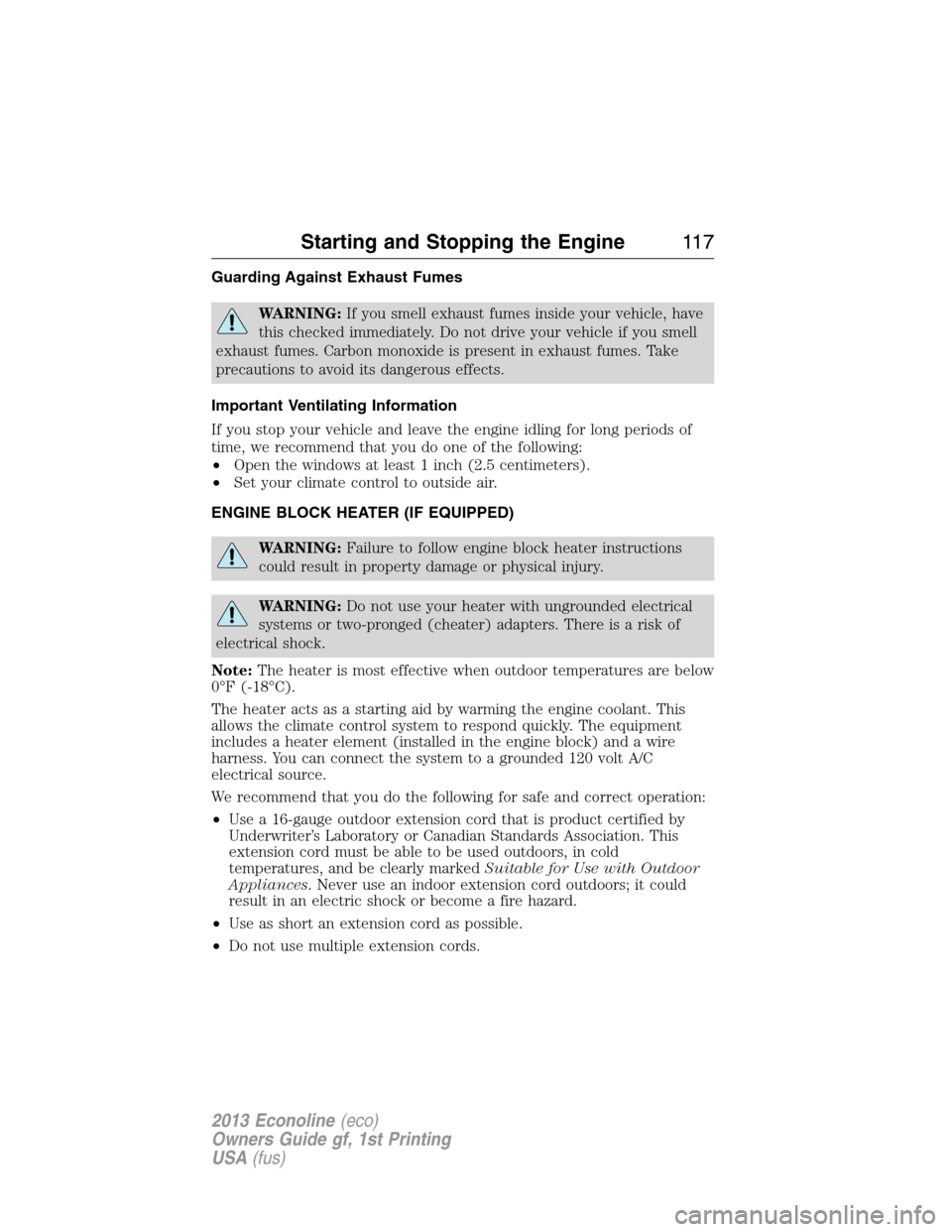
Guarding Against Exhaust Fumes
WARNING:If you smell exhaust fumes inside your vehicle, have
this checked immediately. Do not drive your vehicle if you smell
exhaust fumes. Carbon monoxide is present in exhaust fumes. Take
precautions to avoid its dangerous effects.
Important Ventilating Information
If you stop your vehicle and leave the engine idling for long periods of
time, we recommend that you do one of the following:
•Open the windows at least 1 inch (2.5 centimeters).
•Set your climate control to outside air.
ENGINE BLOCK HEATER (IF EQUIPPED)
WARNING:Failure to follow engine block heater instructions
could result in property damage or physical injury.
WARNING:Do not use your heater with ungrounded electrical
systems or two-pronged (cheater) adapters. There is a risk of
electrical shock.
Note:The heater is most effective when outdoor temperatures are below
0°F (-18°C).
The heater acts as a starting aid by warming the engine coolant. This
allows the climate control system to respond quickly. The equipment
includes a heater element (installed in the engine block) and a wire
harness. You can connect the system to a grounded 120 volt A/C
electrical source.
We recommend that you do the following for safe and correct operation:
•Use a 16-gauge outdoor extension cord that is product certified by
Underwriter’s Laboratory or Canadian Standards Association. This
extension cord must be able to be used outdoors, in cold
temperatures, and be clearly markedSuitable for Use with Outdoor
Appliances. Never use an indoor extension cord outdoors; it could
result in an electric shock or become a fire hazard.
•Use as short an extension cord as possible.
•Do not use multiple extension cords.
Starting and Stopping the Engine11 7
2013 Econoline(eco)
Owners Guide gf, 1st Printing
USA(fus)
Page 199 of 416
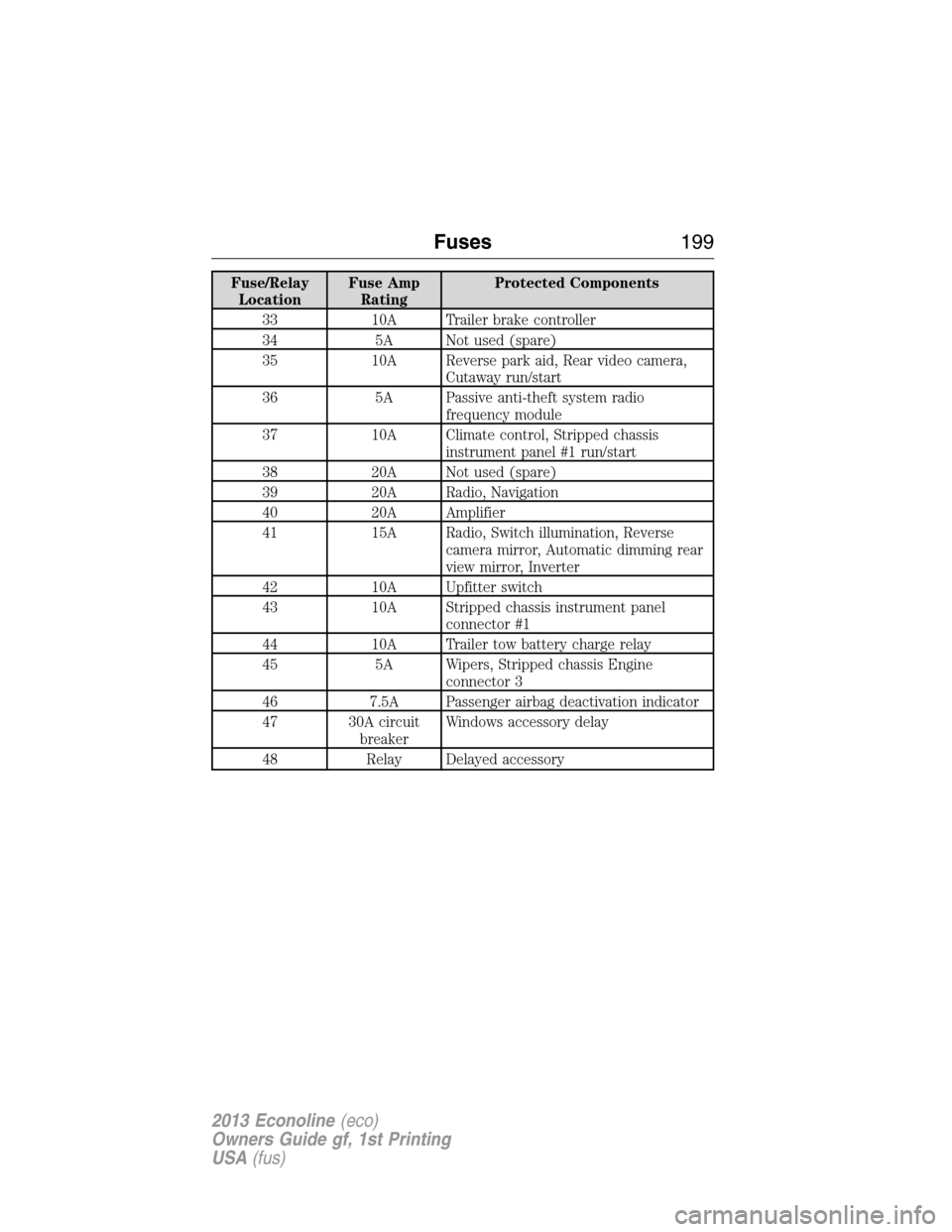
Fuse/Relay
LocationFuse Amp
RatingProtected Components
33 10A Trailer brake controller
34 5A Not used (spare)
35 10A Reverse park aid, Rear video camera,
Cutaway run/start
36 5A Passive anti-theft system radio
frequency module
37 10A Climate control, Stripped chassis
instrument panel #1 run/start
38 20A Not used (spare)
39 20A Radio, Navigation
40 20A Amplifier
41 15A Radio, Switch illumination, Reverse
camera mirror, Automatic dimming rear
view mirror, Inverter
42 10A Upfitter switch
43 10A Stripped chassis instrument panel
connector #1
44 10A Trailer tow battery charge relay
45 5A Wipers, Stripped chassis Engine
connector 3
46 7.5A Passenger airbag deactivation indicator
47 30A circuit
breakerWindows accessory delay
48 Relay Delayed accessory
Fuses199
2013 Econoline(eco)
Owners Guide gf, 1st Printing
USA(fus)
Page 244 of 416
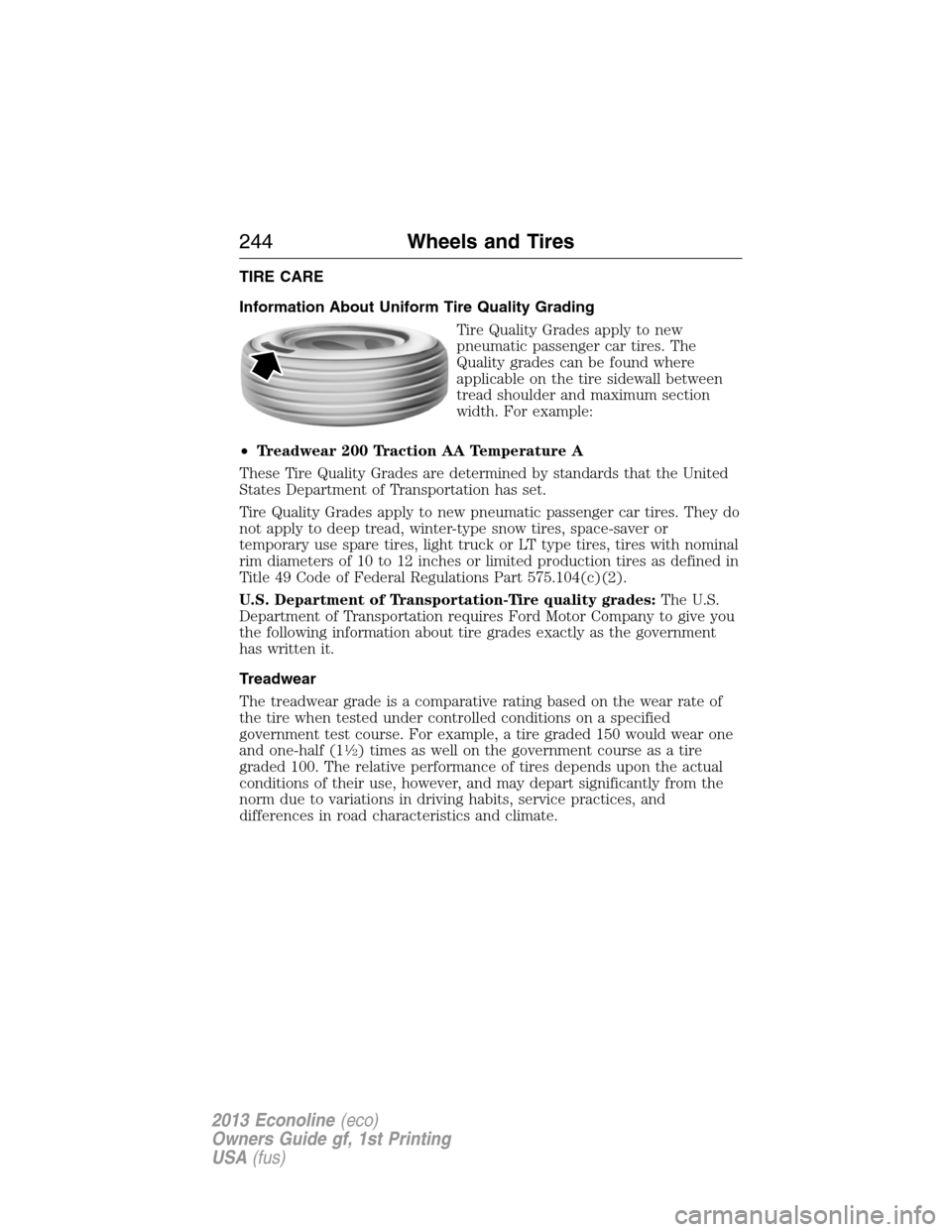
TIRE CARE
Information About Uniform Tire Quality Grading
Tire Quality Grades apply to new
pneumatic passenger car tires. The
Quality grades can be found where
applicable on the tire sidewall between
tread shoulder and maximum section
width. For example:
•Treadwear 200 Traction AA Temperature A
These Tire Quality Grades are determined by standards that the United
States Department of Transportation has set.
Tire Quality Grades apply to new pneumatic passenger car tires. They do
not apply to deep tread, winter-type snow tires, space-saver or
temporary use spare tires, light truck or LT type tires, tires with nominal
rim diameters of 10 to 12 inches or limited production tires as defined in
Title 49 Code of Federal Regulations Part 575.104(c)(2).
U.S. Department of Transportation-Tire quality grades:The U.S.
Department of Transportation requires Ford Motor Company to give you
the following information about tire grades exactly as the government
has written it.
Treadwear
The treadwear grade is a comparative rating based on the wear rate of
the tire when tested under controlled conditions on a specified
government test course. For example, a tire graded 150 would wear one
and one-half (1
1�2) times as well on the government course as a tire
graded 100. The relative performance of tires depends upon the actual
conditions of their use, however, and may depart significantly from the
norm due to variations in driving habits, service practices, and
differences in road characteristics and climate.
244Wheels and Tires
2013 Econoline(eco)
Owners Guide gf, 1st Printing
USA(fus)
Page 261 of 416
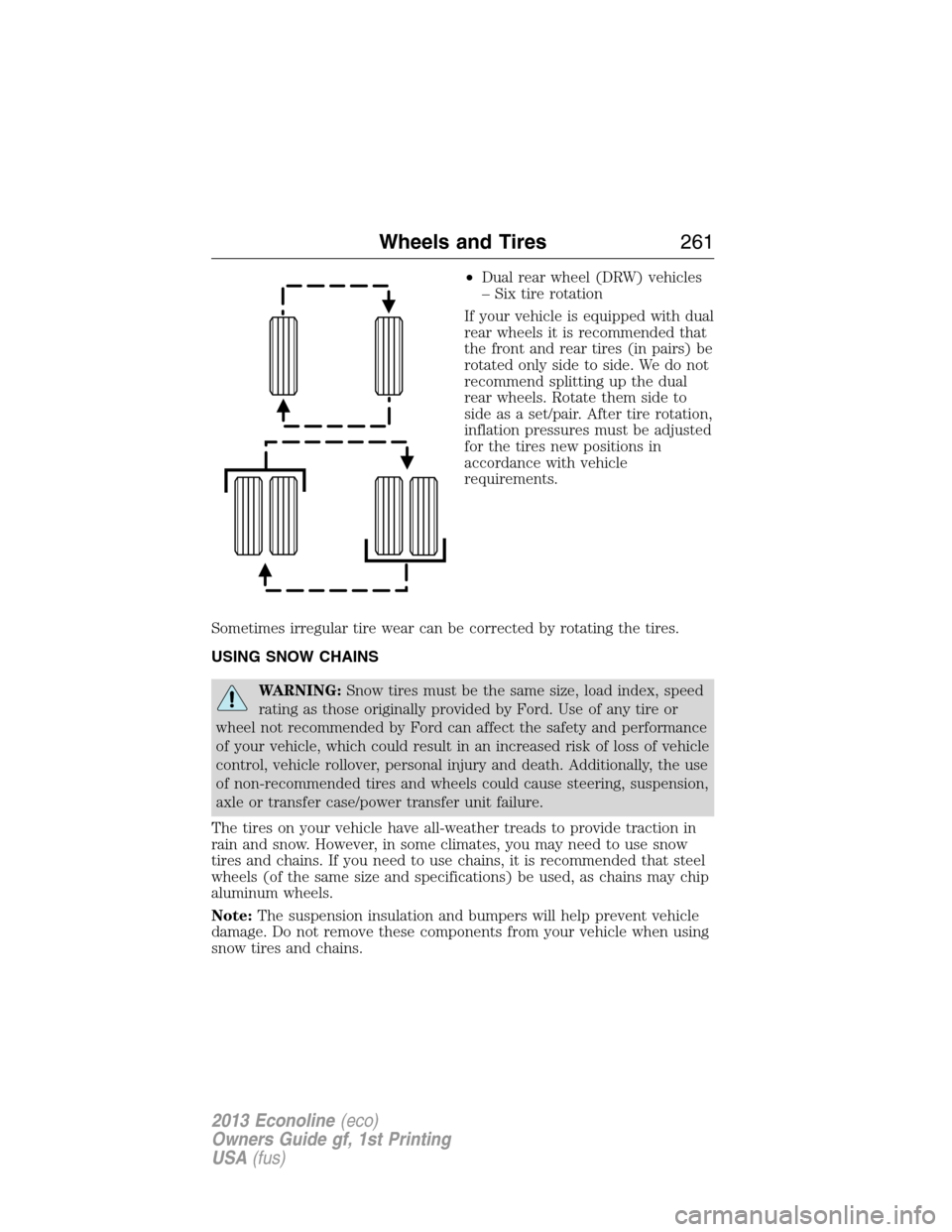
•Dual rear wheel (DRW) vehicles
– Six tire rotation
If your vehicle is equipped with dual
rear wheels it is recommended that
the front and rear tires (in pairs) be
rotated only side to side. We do not
recommend splitting up the dual
rear wheels. Rotate them side to
side as a set/pair. After tire rotation,
inflation pressures must be adjusted
for the tires new positions in
accordance with vehicle
requirements.
Sometimes irregular tire wear can be corrected by rotating the tires.
USING SNOW CHAINS
WARNING:Snow tires must be the same size, load index, speed
rating as those originally provided by Ford. Use of any tire or
wheel not recommended by Ford can affect the safety and performance
of your vehicle, which could result in an increased risk of loss of vehicle
control, vehicle rollover, personal injury and death. Additionally, the use
of non-recommended tires and wheels could cause steering, suspension,
axle or transfer case/power transfer unit failure.
The tires on your vehicle have all-weather treads to provide traction in
rain and snow. However, in some climates, you may need to use snow
tires and chains. If you need to use chains, it is recommended that steel
wheels (of the same size and specifications) be used, as chains may chip
aluminum wheels.
Note:The suspension insulation and bumpers will help prevent vehicle
damage. Do not remove these components from your vehicle when using
snow tires and chains.
Wheels and Tires261
2013 Econoline(eco)
Owners Guide gf, 1st Printing
USA(fus)
Page 411 of 416
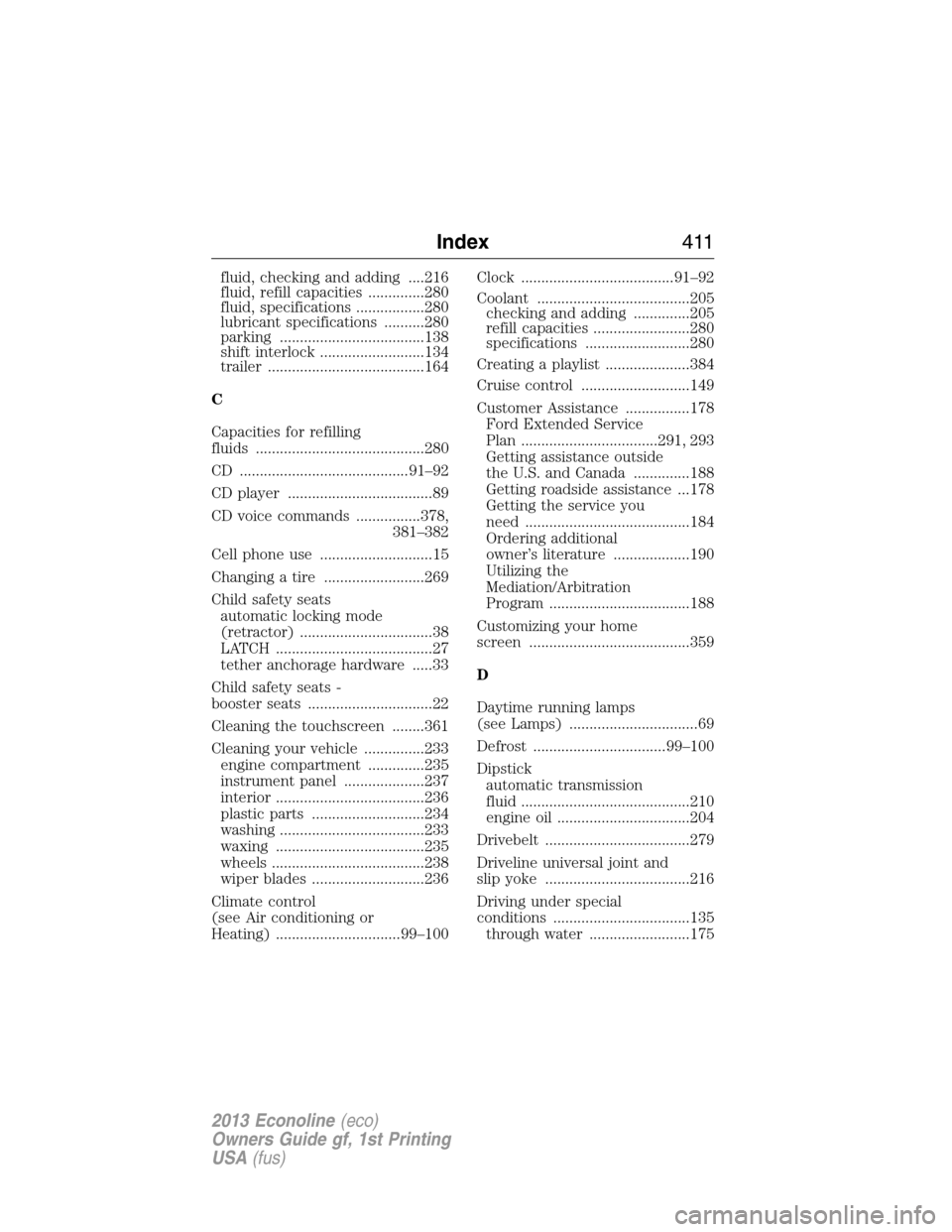
fluid, checking and adding ....216
fluid, refill capacities ..............280
fluid, specifications .................280
lubricant specifications ..........280
parking ....................................138
shift interlock ..........................134
trailer .......................................164
C
Capacities for refilling
fluids ..........................................280
CD ..........................................91–92
CD player ....................................89
CD voice commands ................378,
381–382
Cell phone use ............................15
Changing a tire .........................269
Child safety seats
automatic locking mode
(retractor) .................................38
LATCH .......................................27
tether anchorage hardware .....33
Child safety seats -
booster seats ...............................22
Cleaning the touchscreen ........361
Cleaning your vehicle ...............233
engine compartment ..............235
instrument panel ....................237
interior .....................................236
plastic parts ............................234
washing ....................................233
waxing .....................................235
wheels ......................................238
wiper blades ............................236
Climate control
(see Air conditioning or
Heating) ...............................99–100Clock ......................................91–92
Coolant ......................................205
checking and adding ..............205
refill capacities ........................280
specifications ..........................280
Creating a playlist .....................384
Cruise control ...........................149
Customer Assistance ................178
Ford Extended Service
Plan ..................................291, 293
Getting assistance outside
the U.S. and Canada ..............188
Getting roadside assistance ...178
Getting the service you
need .........................................184
Ordering additional
owner’s literature ...................190
Utilizing the
Mediation/Arbitration
Program ...................................188
Customizing your home
screen ........................................359
D
Daytime running lamps
(see Lamps) ................................69
Defrost .................................99–100
Dipstick
automatic transmission
fluid ..........................................210
engine oil .................................204
Drivebelt ....................................279
Driveline universal joint and
slip yoke ....................................216
Driving under special
conditions ..................................135
through water .........................175
Index411
2013 Econoline(eco)
Owners Guide gf, 1st Printing
USA(fus)